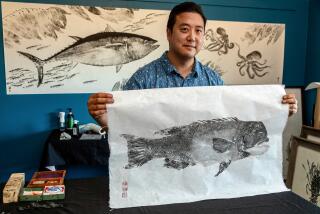Old Fish Give 6th-Graders Fresh Look at Mummies : Science: Students get a hands-on lesson in Egyptian history as they help embalm three croakers. Which one will stink first?
- Share via
EAGLE ROCK — What do fish brains and nylon gauze have to do with ancient Egypt? A class of gifted sixth-graders from Yorkdale Elementary School is eager to explain.
In a field trip that combined hands-on science with a tempting glimpse at the halls of higher education, students visited an Occidental College biology lab Tuesday to wrap up a unit spent studying the culture of the Pharaohs.
The unifying props: three fish, poised for mummification in varying combinations of formaldehyde, salt, olive oil, and gauze dipped in eucalyptus tea.
While teacher Sherry Schwartz concedes the ancient Egyptians didn’t waste their efforts preparing fish for the afterlife, she saw the experiment as the perfect way to tie social studies to science.
“We’ve been studying ancient Egypt, and they’ve been so excited about mummification and the whole culture,” Schwartz said. “Whenever I go anywhere, I talk to everybody about my class. Somebody said, ‘Well you know, I heard you could mummify a fish.’ And it just stayed with me.”
Her students’ enthusiasm matches Schwartz’s own:
“I really liked it. If I would do that to a cat or an animal more like a human it would be an even greater experience,” said 12-year-old Gabriel Chipe.
Although Chipe said he learned in school that the Egyptians used 450 feet of linen to mummify humans and removed the brains through the nostrils, mummifying fish requires modified techniques.
“The fish don’t have any nostrils,” he said. “They have gills.”
“I liked when we got to see the intestines of the fish,” said Sonia Solana, 11. “And I learned that there were a lot of stages in the process (of mummification) and that fish were very different from humans and that they had very small brains--smaller than a peanut.”
The victims of Tuesday’s experiment: three croakers, which are fish commonly found off the coast of California, said environmental biology professor John Stephens, who hosted the 26 students in his lab at the Eagle Rock college. One of the fish had been sitting in formaldehyde for two decades.
The goal: to mummify the fish using various methods and let the students monitor the progress. They are already theorizing.
“Fish A, he took out the intestines, didn’t embalm it or anything and wrapped it in eucalyptus leaves and nylon gauze,” explained Po Ung, 12. “Fish B, he embalmed it (by keeping it in formaldehyde), took out everything, oiled it and wrapped it. And fish C, he wanted to do an experiment and just wrap it (without removing any organs).
“Fish B is embalmed, so I think that will last longer. Fish C probably will stink faster. And Fish A maybe will be the second one to decay,” Ung said.
Although the morning visit involved some exclamations of ‘Yuck!’--one student was squirted with eye juice--Schwartz’s students take their subject seriously.
“I think it was really interesting the way (the Egyptians) thought about death a lot, how they thought about the afterlife and wanted to protect the body from decaying so it will be ready,” said Vanessa Rodriguez, 12. “They took the brain out and they didn’t know what it was for. They just threw it away. They thought the heart did all the thinking.”
Yorkdale, in Highland Park, is one of three Los Angeles schools that Occidental College has adopted as part of a program to expose the students--many of them minority youngsters from lower-income families--to higher education. Occidental’s director of community relations, Carlos Chavez, said he was happy to indulge Schwartz in her fish fantasy.
“It seemed a little out of the ordinary, but I thought, ‘I’m sure a member of our faculty would know how to do that,’ ” Chavez said. “So I started calling around to some of my friends in geology, biology, and everybody pointed to John Stephens as the man who would know how to do it.”
Stephens winged it.
“I thought they were nuts. I still think they were, but I think the kids enjoyed it,” he said. “I didn’t think the Egyptians had ever done fish. But they had done cats. Cats, of course, were worshiped, so there were a lot of things they did for cats.”
Although Stephens had readily agreed to host the group, the appointment had slipped his mind until about an hour before the kids arrived. He had to do some quick thinking.
“I could remember as a kid watching the mummy movies, and they always heated eucalyptus in a bowl to get the fragrance. So I went out and got some eucalyptus,” Stephens said. “I’d gotten some gauze from the trainer here. I had some fish in the freezer, and I cook a little bit in the back lab, so I had some olive oil.”
Once the presentation got started, however, the students ran the show.
“I took out the preserved fish, and let them look at the brain. Then they wanted the eyes out. Then they wanted to see the heart. . . . They were fun, bright kids,” he said. One student wanted to know where he could get his own mummification tools.
For some, Tuesday’s trip was the first to a college--something that can make a big impression, said Chavez, who explained to the students at lunch what grants he had received to go to school, and how he got his job.
He seemed to get his message across.
“I think I do pretty good at school. But now I’m going to try even harder,” said Chipe.







